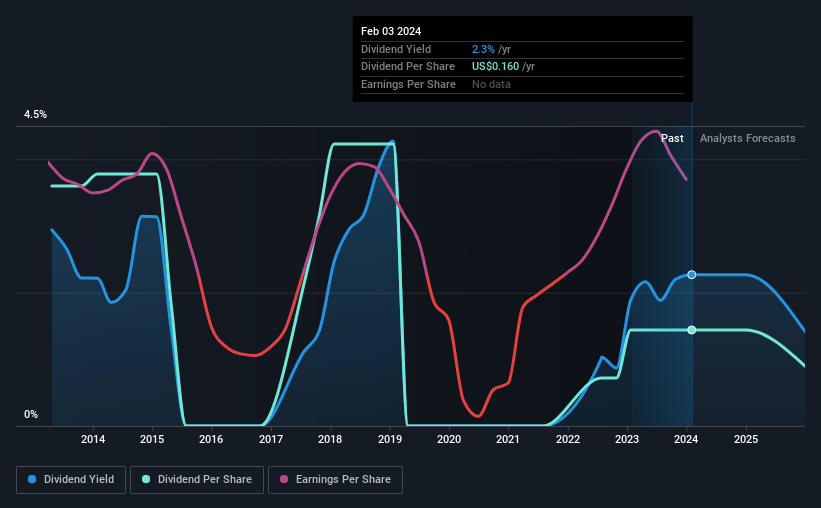RPC (NYSE:RES) Could Be A Buy For Its Upcoming Dividend
Readers hoping to buy RPC, Inc. (NYSE:RES) for its dividend will need to make their move shortly, as the stock is about to trade ex-dividend. The ex-dividend date is usually set to be one business day before the record date which is the cut-off date on which you must be present on the company's books as a shareholder in order to receive the dividend. It is important to be aware of the ex-dividend date because any trade on the stock needs to have been settled on or before the record date. In other words, investors can purchase RPC's shares before the 8th of February in order to be eligible for the dividend, which will be paid on the 11th of March.
The company's next dividend payment will be US$0.04 per share. Last year, in total, the company distributed US$0.16 to shareholders. Calculating the last year's worth of payments shows that RPC has a trailing yield of 2.3% on the current share price of US$7.05. If you buy this business for its dividend, you should have an idea of whether RPC's dividend is reliable and sustainable. We need to see whether the dividend is covered by earnings and if it's growing.
See our latest analysis for RPC
Dividends are typically paid out of company income, so if a company pays out more than it earned, its dividend is usually at a higher risk of being cut. RPC is paying out just 18% of its profit after tax, which is comfortably low and leaves plenty of breathing room in the case of adverse events. Yet cash flows are even more important than profits for assessing a dividend, so we need to see if the company generated enough cash to pay its distribution. What's good is that dividends were well covered by free cash flow, with the company paying out 16% of its cash flow last year.
It's positive to see that RPC's dividend is covered by both profits and cash flow, since this is generally a sign that the dividend is sustainable, and a lower payout ratio usually suggests a greater margin of safety before the dividend gets cut.
Click here to see the company's payout ratio, plus analyst estimates of its future dividends.
Have Earnings And Dividends Been Growing?
Stocks in companies that generate sustainable earnings growth often make the best dividend prospects, as it is easier to lift the dividend when earnings are rising. If business enters a downturn and the dividend is cut, the company could see its value fall precipitously. This is why it's a relief to see RPC earnings per share are up 2.4% per annum over the last five years. RPC is retaining more than three-quarters of its earnings and has a history of generating some growth in earnings. We think this is a reasonable combination.
The main way most investors will assess a company's dividend prospects is by checking the historical rate of dividend growth. RPC's dividend payments per share have declined at 8.8% per year on average over the past 10 years, which is uninspiring. RPC is a rare case where dividends have been decreasing at the same time as earnings per share have been improving. It's unusual to see, and could point to unstable conditions in the core business, or more rarely an intensified focus on reinvesting profits.
The Bottom Line
Should investors buy RPC for the upcoming dividend? Earnings per share have been growing moderately, and RPC is paying out less than half its earnings and cash flow as dividends, which is an attractive combination as it suggests the company is investing in growth. It might be nice to see earnings growing faster, but RPC is being conservative with its dividend payouts and could still perform reasonably over the long run. It's a promising combination that should mark this company worthy of closer attention.
While it's tempting to invest in RPC for the dividends alone, you should always be mindful of the risks involved. To help with this, we've discovered 1 warning sign for RPC that you should be aware of before investing in their shares.
If you're in the market for strong dividend payers, we recommend checking our selection of top dividend stocks.
Have feedback on this article? Concerned about the content? Get in touch with us directly. Alternatively, email editorial-team (at) simplywallst.com.
This article by Simply Wall St is general in nature. We provide commentary based on historical data and analyst forecasts only using an unbiased methodology and our articles are not intended to be financial advice. It does not constitute a recommendation to buy or sell any stock, and does not take account of your objectives, or your financial situation. We aim to bring you long-term focused analysis driven by fundamental data. Note that our analysis may not factor in the latest price-sensitive company announcements or qualitative material. Simply Wall St has no position in any stocks mentioned.

